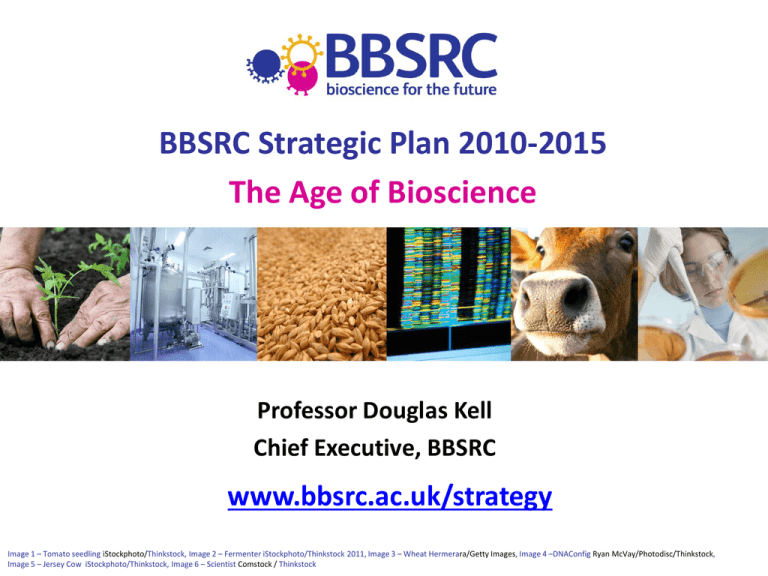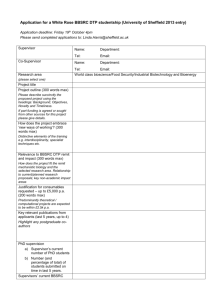BBSRC Strategic Plan 2010-2015 The Age of Bioscience www.bbsrc.ac.uk/strategy Professor Douglas Kell
advertisement

BBSRC Strategic Plan 2010-2015 The Age of Bioscience Professor Douglas Kell Chief Executive, BBSRC www.bbsrc.ac.uk/strategy Image 1 – Tomato seedling iStockphoto/Thinkstock, Image 2 – Fermenter iStockphoto/Thinkstock 2011, Image 3 – Wheat Hermerara/Getty Images, Image 4 –DNAConfig Ryan McVay/Photodisc/Thinkstock, Image 5 – Jersey Cow iStockphoto/Thinkstock, Image 6 – Scientist Comstock / Thinkstock BBSRC Strategic Plan 2010 - 2015: The Age of Bioscience Driven by new tools and technologies ….never before have researchers been able to address such a breadth and depth of biological questions…. World-class bioscience Three major strategic science priorities Three crucial enabling themes Three major strategic science priorities © www.micrographia.com 2011 Hemera © Thinkstock 2011 Food Security (Grand Challenges) Bioenergy and Industrial Biotechnology iStockphoto © Thinkstock 2011 Basic bioscience underpinning health Three crucial enabling themes Ryan McVay/Photodisc © Thinkstock 2011 KE, innovation and skills Exploiting new ways of working © Jupiter Images Corporation 2010 Partnerships Food security How do we feed 9 billion sustainably by 2050? The perfect storm of energy, food and water shortages 2030 Research is essential to meet the huge challenge Food & Drink: £80Bn UK industry, 3.6M jobs Farming: 55,000 rural businesses; 0.5M jobs Global poultry industry: £75Bn, underpinned by UK science Food Security Some BBSRC priorities • GFS programme: Joining up research through BBSRC leadership • Position UK as a Global leader in wheat: Wheat genome 5x coverage £7M for public wheat pre-breeding programme (sLoLa) • Reducing GHG emissions from Agriculture: Living with Env. Change (LwEC) • Transformational research: enhancing photosynthesis • Underpinning the livestock sector: productivity, sustainability, health and welfare Hemera © Thinkstock 2011 Hemera © Thinkstock 2011 Hemera © Thinkstock 2011 Michael Blann/Digital Vision, © Thinkstock 2011 Hemera Technologies © Getty Images 2011 © Jupiter Images Corporation2009 iStockphoto © Thinkstock 2011 Global Food Security • Brings together the major public funders of food-related research to tackle the challenge of feeding 9bn people sustainably by 2050 • Collective spend ~£426M per year • Fosters a multidisciplinary approach to this very complex challenge • Ensures added value by minimising duplication and maximising synergies across funders • Long-term though there will be quick wins Industrial Biotechnology including bioenergy Just some of the uses of IB: • Petrochemical replacement • De novo source plastics & polymers • ‘Advanced Pharmaceutical Ingredients’ • New biologics • Food & drink • Paper & pulp production • Textile production & finishing • Detergents • Starch industry (underpinning fermentation, binders, solvents, lubricants etc…) • Energy (bioethanol; biodiesel) • Agriculture (biomass, feedstocks) Image courtesy S.Martin, TMO Renewables LTD Building a low carbon economy requires new ways to produce energy, transport fuels, chemicals and industrial feedstocks. Energy and industrial materials from bio-based sources Global biotech sales projected at 10x growth to £360Bn in next 15 years UK biotech clusters: most innovative outside USA; 800 medical SMEs; £4.2Bn turnover (1/3 of total EU) Industrial Biotechnology Some BBSRC priorities • Build UK research capacity and industrial collaboration • Industrial Biotechnology: whole cell and enzymatic systems; new biocatalysts and pathways; high-value chemicals from plants • Bioenergy: emphasis on liquid transport fuels beyond ethanol, with coproducts Building on BBSRC Sustainable Bioenergy Centre (BSBEC) BBSRC leading on bioenergy within RCUK Energy programme • Synthetic biology for industrial biotechnology • Metagenomics: discovery of new gene products, enzymes and pathways Hemera Technologies/Ablestock.com ©Getty Images 2011 © Rothamsted Research Ltd © Paul Dupree © Paul Dupree Image courtesy S.Martin, TMO Renewables LTD Ryan McVay/Photodisc ©Thinkstock 2011 Knowledge-Based BioEconomy (KBBE) European Commission & Council see Biotechnology as one of 4 or 5 key enabling technologies for the future – principally the use of plants and microbes to replace the host of high-value chemicals and liquid fuels that are currently derived from fossil carbon. 14th Sept. 2010: injection of €1.7 Billion into KBBE as part of FP7 – good signs for Horizon 2020. Basic bioscience underpinning health Lifespan is increasing faster than healthspan The ageing society is a major challenge for 21st century Basic bioscience underpins pharmaceutical development and biotech industries Older people absorb ~43% of NHS budget - £35-40Bn p.a. Food-related illness costs NHS £6Bn annually (Cabinet Food Matters 2008) UK pharma industry generated £21Bn of exports in 2008-9 & invested £4.5Bn in UK R&D. iStockphoto © Thinkstock 2011 Bioscience underpinning health Some BBSRC priorities • Ageing: mechanisms of healthy ageing (gut, brain, immune system) • Focus and co-ordinate ageing research: with MRC and others • Combating zoonotic disease: ‘one medicine’ • Biopharmaceuticals: new leads, improved yield and purity, cheaper Hemera © Thinkstock 2011 Comstock © Thinkstock 2011 iStockphoto © Thinkstock 2011 Photodisc © Thinkstock 2011 • Develop strategic engagement with industry: enable open innovation, collaborative research iStockphoto © Thinkstock 2011 Hemera © Thinkstock 2011 In confidence Research grants analysis 2009/10: £290M Bioenergy and industrial biotechnology (£33M) Food security (£101M) Institute: £8.5M Basic bioscience underpinning health (£29M) HEI: £39.0M HEI: £24.7M Institute: £62.3M Institute: £5.3M HEI: £23.4M Addressing a strategic priority: £146M Addressing a strategic priority: £146M Not addressing a strategic priority (other world-class bioscience): £144M World-class underpinning bioscience: £144M Three major strategic science priorities © www.micrographia.com 2011 Hemera © Thinkstock 2011 Food Security (Grand Challenges) Bioenergy and Industrial Biotechnology iStockphoto © Thinkstock 2011 Basic bioscience underpinning health Three crucial enabling themes Ryan McVay/Photodisc © Thinkstock 2011 KE, innovation and skills Exploiting new ways of working © Jupiter Images Corporation 2010 Partnerships Knowledge exchange, innovation and skills Ensuring that our worldclass science and skilled people have widest possible impact Boosting the UK economy, connecting to policy and improving quality of life. • Skills and capabilities • KE and translation • Promoting innovation • Culture change Some BBSRC priorities • Emerging businesses of tomorrow: including growth through SMEs • Strengthen academic-industry links: and links with other users • Working with TSB: £50M complementary and collaborative funding. Agri-food, regenerative medicine, IB, emerging technologies • Understanding and supporting translation pathways: e.g. expansion of Follow-on Fund to gain from existing research iStockphoto © Thinkstock 2011 Hemera © Thinkstock 2011 Hemera © Thinkstock 2011 © Zyoxel Ltd Some BBSRC Priorities: • Focus on excellence in PhD training: new DTP scheme, combining scientific and professional development. Fewer but better funded PhDs • Deliver skills for economic growth: strengthening user relevant training, CASE • Refocus our fellowship schemes: developing the research leaders of tomorrow • Increase training mobility and capabilities: more movement between academia and user sectors, public-private training partnerships e.g. ATPs Exploiting new ways of working Innovative ways of working in an era of rapid technology change Next generation internet In silico research Quantitative and computational bioscience Bioscience IS big data science Ryan McVay/Photodisc © Thinkstock 2011 Some BBSRC priorities • New tools and technologies: dedicated funding for tools and resources • Data rich bioscience: sharing, standards and interoperability • Bioinformatics: infrastructure and resources (ELIXIR, TGAC) • Integrative and systems biology: embedded and applied 19 Ryan McVay/Photodisc © Thinkstock 2011 Hemera © Thinkstock 2011 Ryan McVay/Photodisc © Thinkstock 2011 Comstock © Thinkstock 2011 iStockphoto © Thinkstock 2011 Partnerships Working with others to deliver our exciting vision for UK bioscience • Researchers • HEIs • Other funders • Policy-makers • Industry • Public • International organisations • and many more.... Working with HEIs Through increased dialogue with leading HEIs enable a more strategic, joined-up and efficient approach to investing in UK Bioscience for impact Outcomes: (examples) • Synergy and added value in delivery of bioscience and impact • Networking main HEIs/Institutes; sharing of ideas and spark collaborations • Efficiency opportunities for sharing of big equipment and facilities • Leverage and confidence to allocate HEI resource and make appointments • Performance management e.g. success rates, feedback • Critical friends for BBSRC Funding Opportunities: www.bbsrc.ac.uk/funding/opportunities Responsive mode: • responsive mode research priorities • highlight notices sLoLa: • 2012 sLoLa call to be launched on 31st January. Deadline for outlines: 15 March 2011 Hemera Technologies/Ablestock.com ©Getty Images 2011 © Rothamsted Research Ltd © Paul Dupree © Paul Dupree Image courtesy S.Martin, TMO Renewables LTD Ryan McVay/Photodisc ©Thinkstock 2011 Communication channels Follow us @BBSRC @BBSRC_ERU @dbkell News feed: http://feeds.feedburner.com/bbsrc News on our website: http://www.bbsrc.ac.uk/media/news/newsindex.aspx http://blogs.bbsrc.ac.uk/ Professor Douglas Kell's blog News, thoughts and facts from the Chief Executive of the Biotechnology and Biological Sciences Research Council Subscribe to our News email: http://www.bbsrc.ac.uk/media/newsemail.aspx 24






